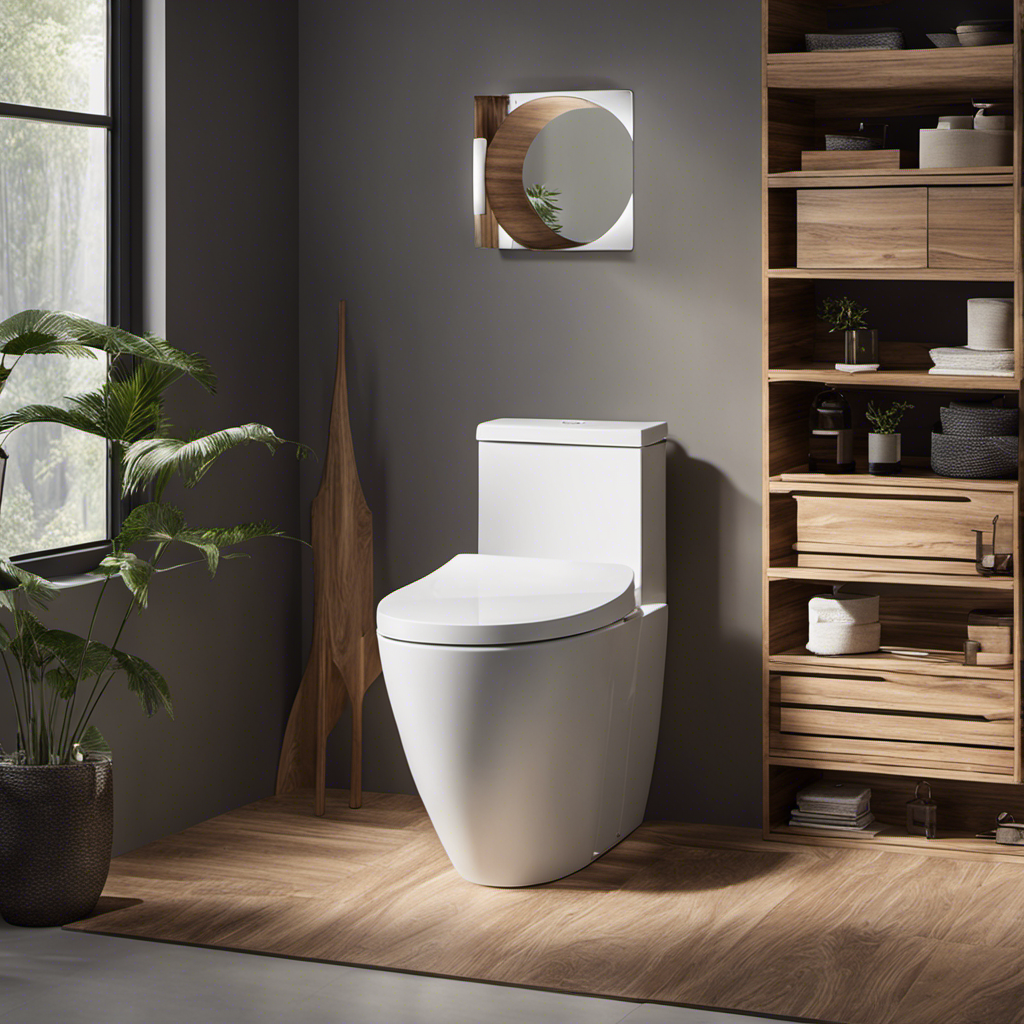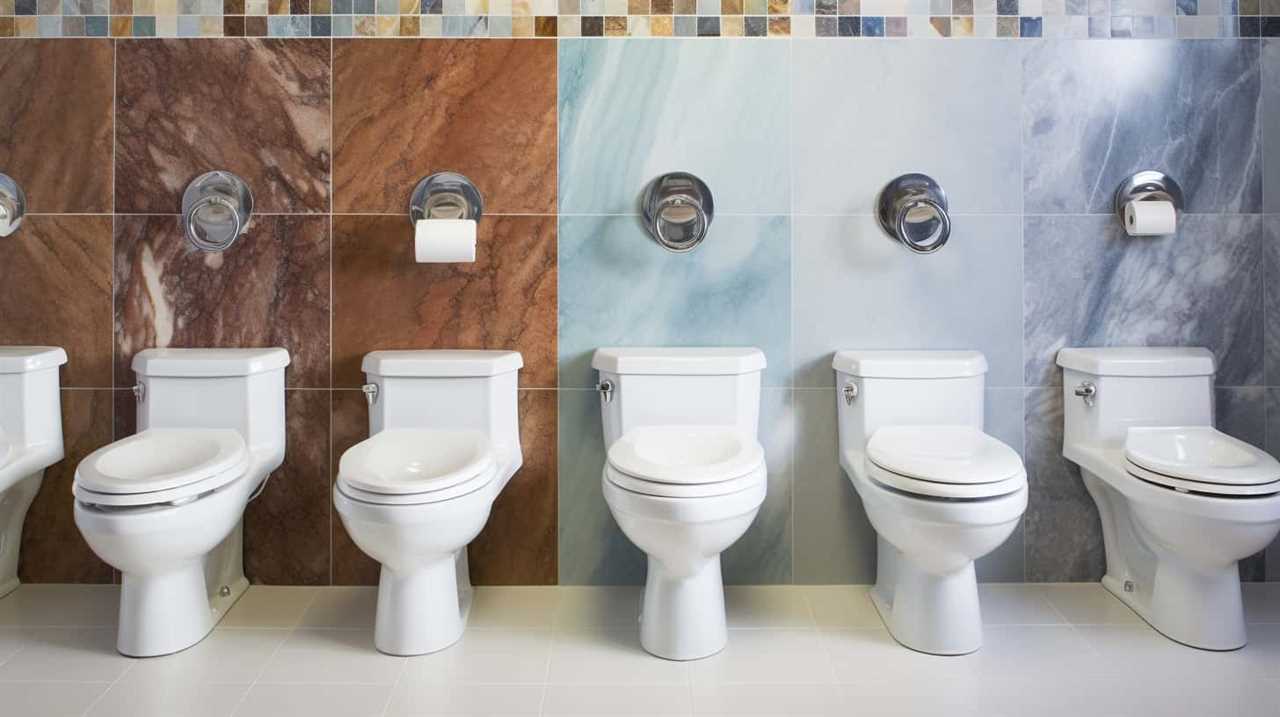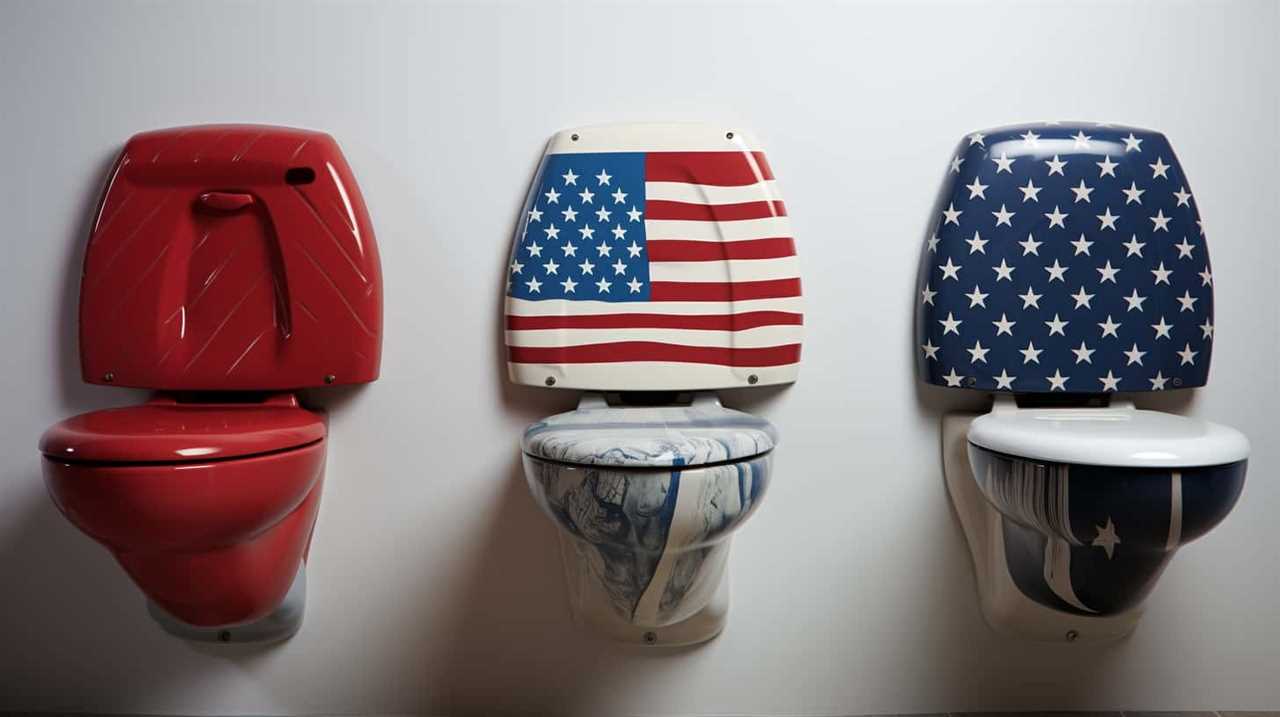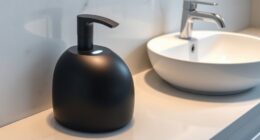As I sat down on my old, worn-out plastic toilet seat, I couldn’t help but wonder if there was a better option out there. That’s when I decided to delve into the world of toilet seat materials and compare the two most popular choices: wood and plastic.
In this comprehensive comparison, I will explore the factors to consider when choosing a toilet seat, such as comfort, hygiene, durability, and style.
So, if you’re in the market for a new toilet seat, join me as we navigate the pros and cons of wood and plastic.
Key Takeaways
- Wood seats provide warmth and coziness, while plastic seats lack the cozy feeling.
- Plastic seats are easier to clean with antibacterial soap and water, while wood seats require non-abrasive cleaning and may absorb water and urine if scratched.
- Both plastic and wood seats can last for several years with proper care and maintenance, but wooden seats may deteriorate quicker and may require sanding and varnishing.
- Wood seats add a classy and aesthetic look to a bathroom, while plastic seats come in various colors and styles to match bathroom design.
Factors to Consider When Choosing a Toilet Seat
When choosing a toilet seat, I consider factors such as comfort, hygiene, durability, and style.
In terms of material comparison, plastic seats are generally cheaper and lighter than wood seats. They also come in a wider range of colors and styles to match any bathroom design.
On the other hand, wood seats are more durable and long-lasting. They provide better comfort for prolonged use and give a bathroom a classy and aesthetic look.
In terms of hygiene, plastic seats are easy to wash with antibacterial soap and water. However, wood seats can be absorbent and require non-abrasive cleaning.
When it comes to durability, both plastic and wood seats can last for several years, but wooden seats may deteriorate quicker and require more maintenance.
Considering cost and affordability, plastic seats are generally more budget-friendly compared to wood seats.
Ultimately, the decision between the two materials depends on personal preference, budget, and the desired look and feel for your bathroom.
Comfort: Wood Vs Plastic
I prefer the warmth and comfort of a wood toilet seat, especially during the colder months. Wood seats provide a cozy feeling that plastic seats lack. When it comes to comfort, wood seats are the clear winner.
However, there are pros and cons to consider when choosing between wood and plastic toilet seats.
In terms of cleaning methods, plastic seats have an advantage. They are easy to wash with antibacterial soap and water. On the other hand, wood seats require non-abrasive cleaning and may be harder to clean and dry. Wood seats also have the downside of being absorbent, meaning they can absorb water and urine if scratched.
While wood seats may require more maintenance, they are more durable and long-lasting compared to plastic seats. Wood seats also add a touch of elegance and style to any bathroom. Plastic seats, on the other hand, come in a wide variety of colors and styles to match your bathroom design.
Hygiene Considerations
To maintain good hygiene, it is important to consider the cleaning methods and absorbency of the toilet seat material. When it comes to toilet seat materials, there are a few key factors to keep in mind regarding cleaning and maintenance:
-
Plastic seats are easy to clean with antibacterial soap and water. They can be quickly wiped down and are resistant to absorbing water and urine.
-
Wood seats, on the other hand, are more absorbent and can absorb water and urine if scratched. They require non-abrasive cleaning and may take longer to dry.
-
Both plastic and wood seats can last for several years with proper care and maintenance. However, wooden seats may deteriorate quicker and may require sanding and varnishing to prolong their lifespan.
Durability and Maintenance
Maintaining the durability and longevity of both plastic and wood toilet seats is essential for ensuring their extended lifespan. To maximize toilet seat longevity, regular cleaning and proper care are crucial.
For plastic seats, a simple wash with antibacterial soap and water is sufficient. It is important to avoid using abrasive cleaners that can scratch the surface.
Wood seats, on the other hand, require non-abrasive cleaning to prevent scratches. Additionally, they may need periodic sanding and varnishing to maintain their appearance and prevent deterioration.
Both plastic and wood seats can last for several years if cared for properly. However, cheap plastic seats are more prone to breaking and may not withstand heavy use.
Ultimately, regular cleaning and gentle care are key to ensuring the longevity of both plastic and wood toilet seats.
Style and Aesthetics
Considering the style and aesthetics of the toilet seat is important when deciding between wood and plastic options. The design of the toilet seat can greatly impact the overall look and feel of your bathroom decor. Here are some key points to consider:
- Wood seats give a bathroom a classy and aesthetic look, adding a touch of elegance to the space.
- Plastic seats come in various colors and styles, allowing you to match them with your bathroom design seamlessly.
- Wood seats are preferred for a more stylish appearance, as they provide a timeless and sophisticated look.
When choosing a toilet seat, it is essential to consider the overall design and ambiance you want to create in your bathroom. Whether you opt for the warmth and elegance of wood or the versatility and variety of plastic, the style of the toilet seat can make a significant difference in the overall aesthetics of your bathroom.
The Warmth Factor: Wood Vs Plastic
I personally find that the warmth of a wood toilet seat adds a cozy and inviting touch to my bathroom. However, when it comes to comparing the warmth factor, wood seats have an advantage over plastic seats. Plastic seats can get cold in the winter, whereas wood seats remain warm all year round.
If you prefer the warmth of a wood seat but also want the convenience of a plastic seat, you can opt for a heated plastic toilet seat. These seats are more expensive but provide the added comfort of warmth during colder months.
When it comes to cleaning, plastic seats are generally easier to clean and maintain. They can be washed with antibacterial soap and water, making it convenient to keep them hygienic. On the other hand, wood seats are absorbent and can absorb water and urine if scratched. They require non-abrasive cleaning and may be harder to clean and dry.
However, both plastic and wood seats can last for several years, with wood seats requiring occasional sanding and varnishing to maintain their durability.
Overall, the warmth factor and cleaning methods are important considerations when choosing between wood and plastic toilet seats.
Final Decision: Which Toilet Seat Material to Choose?
After thoroughly evaluating the warmth factor, cleaning methods, and durability, it is clear that the final decision on which toilet seat material to choose depends on individual preferences and priorities.
When making this decision, there are a few key factors to consider, including cost considerations and eco-friendly options.
-
Cost Considerations: Plastic seats tend to be cheaper and lighter than wood seats, making them a more budget-friendly option. However, wood seats are more durable and long-lasting, which can be a cost-effective choice in the long run.
-
Eco-Friendly Options: If sustainability is a priority, there are eco-friendly alternatives available. Some companies offer toilet seats made from recycled materials or sustainable wood sources, reducing the environmental impact.
Ultimately, the choice between wood and plastic toilet seats will depend on personal preferences, such as comfort, hygiene, durability, style, and budget. Considering all these factors will help you make an informed decision that meets your individual needs.
Frequently Asked Questions
Are There Any Health Concerns Associated With Using Plastic or Wood Toilet Seats?
There are potential health concerns with both plastic and wood toilet seats. Plastic seats can harbor bacteria if not properly cleaned, while wood seats can absorb water and urine if scratched. Comparing durability, wood seats may require more maintenance.
Can Wood Toilet Seats Be Easily Repaired if They Become Scratched or Damaged?
Yes, wood toilet seats can be easily repaired if scratched or damaged. Advantages of wood seats include durability, comfort, and a stylish appearance. However, they may require sanding and varnishing over time.
Are There Any Eco-Friendly Options Available for Toilet Seats?
Yes, there are eco-friendly options for toilet seats. Sustainable materials like bamboo or recycled plastic can be used to make environmentally friendly toilet seats that are durable and stylish.
Do Plastic Toilet Seats Have Any Advantages Over Wood Seats in Terms of Installation or Compatibility With Different Toilet Models?
Plastic toilet seats have advantages over wood seats in terms of installation and compatibility with different toilet models. Plastic seats are lightweight, easy to install, and fit most standard toilets.
Are There Any Special Considerations to Keep in Mind When Cleaning and Maintaining Wood or Plastic Toilet Seats?
When it comes to cleaning and maintaining toilet seats, there are a few considerations to keep in mind. For wood seats, non-abrasive cleaning is best, while plastic seats can be easily washed with soap and water. Regular maintenance is key for both.
Conclusion
After carefully examining the factors to consider when choosing between wood and plastic toilet seats, it is evident that both materials have their advantages.
Plastic seats offer a more affordable option, with a wide range of colors and styles to choose from.
On the other hand, wood seats provide better durability and comfort.
When making a decision, it is crucial to prioritize factors like hygiene and maintenance.
Ultimately, the choice between wood and plastic toilet seats comes down to personal preference and the desired aesthetic appeal for your bathroom.
So, go ahead and make your throne the most stylish and comfortable seat in the house!










